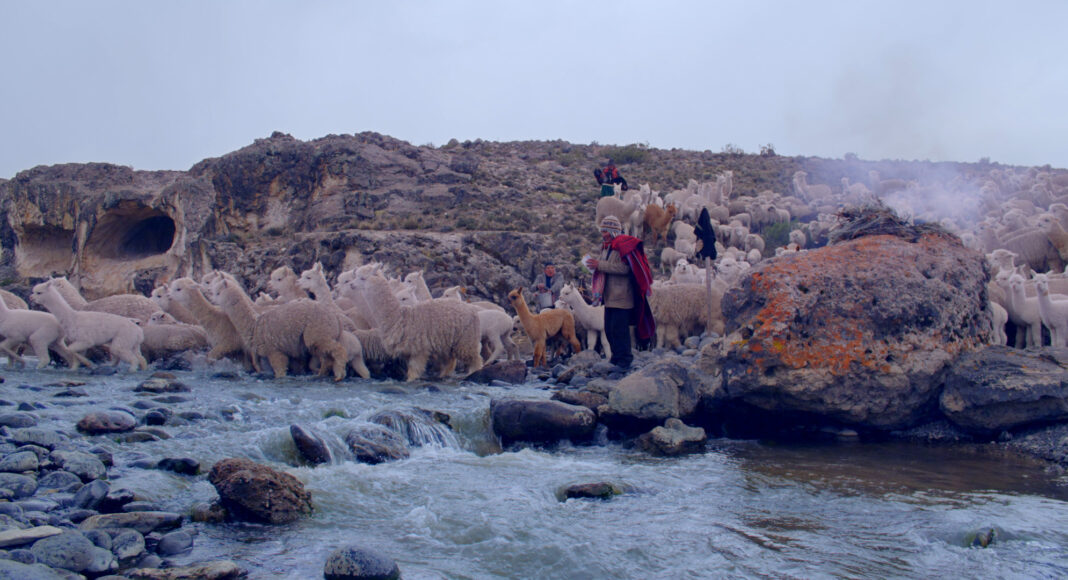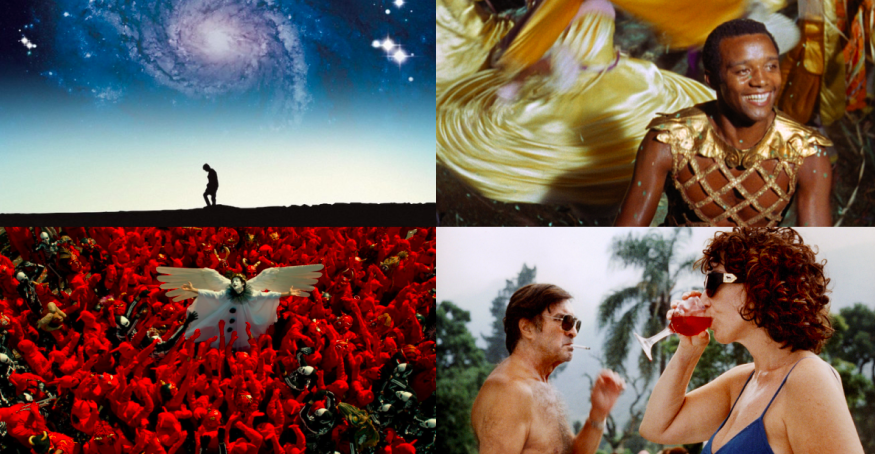Pakucha depicts an Aymara community in Peru’s Puno region as they carry out and celebrate the ritual of ‘uywa ch´uwa’, a fertility ritual in honour of Pakucha: the spirit of the alpaca that lives in the Andes. Taking a slow observational approach, director Tito Catacora places Andean cosmovision at the forefront, challenging conventional modes of documentary filmmaking. The film is part of the fourth Cine Latino Film Festival and will be screened on May 3 at 6.30pm at Bertha DocHouse, London. Tickets here.
– We came here because we trust you.
– We have to help each other always.
– In the name of the deities!
In recent years there has been a rise in the number of films produced outside of Lima, and Pakucha could be viewed as part of the upsurge in Peru’s ‘cine regional’. Defined by Peruvian filmmakers Emilio Bustamente and Jaime Luna Victoria, ‘cine regional’ seeks to differentiate Lima-based cinema from films produced outside of the country’s capital in more rural areas populated by Indigenous communities. Set in Puno, over 800 km from Lima, Pakucha is a continuation of this legacy, particularly after the success of Wiñaypacha (2017), the first Peruvian film in Aymara language directed by Catacora’s late nephew, Óscar. In an interview with Pledge Times, Catacora has stated that he felt a ‘responsibility’ to make Pakucha and to continue his brother’s legacy through filmmaking.
Andean cosmovision: ‘the Andean world is not individualistic, but more collective‘
At the centre of this documentary is this Andean community’s worldview. In Catacora’s words: ‘We consider that the Andean world is not individualistic, but more collective.’ To portray this on-screen, Catacora avoids selecting individual protagonists and emphasizes this collective existence through his composition. As this Aymara community in Puno celebrates the fertility ritual in honour of Pakucha, Catacora packs subjects into the frame and films from above, with no close-up shots throughout the entire film. With no narrative voiceover or direct interviews, their dialogue unfolds naturally and informs the viewer of the ritual they are carrying out.
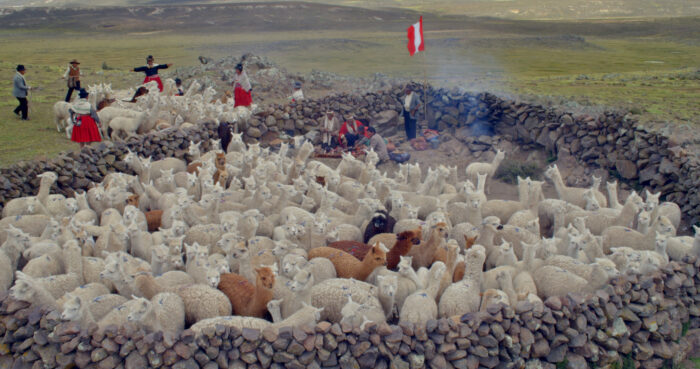
For example, in one scene, three community members sit on a hillside and discuss the significance of the colour of the ashes during the consecration part of the ritual. Despite facing the camera, they are talking amongst themselves and after finishing the ritual they thank the earth and climb up the hillside to exit the frame. It is this avoidance of conventional stylistic features that allows Catacora to successfully reflect the beliefs and customs of this community. He describes Pakucha primarily as an ‘ethnographic documentary’, and in this way allows the community and ritual to speak for themselves, without the interference of the filmmaker.
Connecting forces
An integral part of the Andean worldview is the natural environment. This is reinforced from the very beginning with a definition of Pakucha opening the film: ‘In the magical-realist universe of the Andean cosmovision, the spirit of the Alpaca lives eternally in the sacred mountains of the Andes’. In the following scene, we see a herd of alpacas pouring through the frame, just like the river they are crossing, as they are led to a purification ritual. The fixed camera captures the event in real time, emphasizing the natural forces and connecting the community with their animals and their environment.
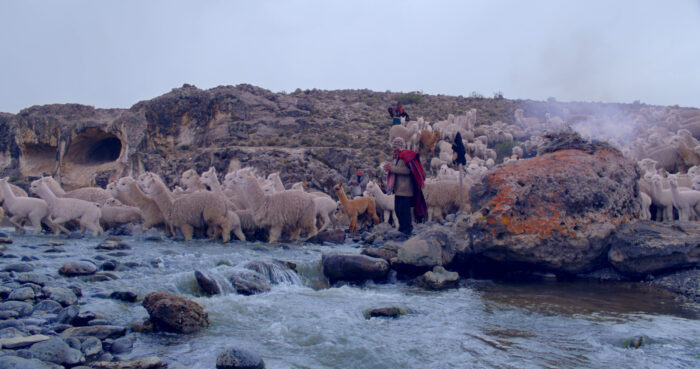
In the same style, this documentary is characterized by wide fixed shots of the mountainous landscape which reveal and make connections between the various community spaces: the mountain where the alpacas are raised and where the sacred fire is lit, the corral where the alpaca is sacrificed, the room where the meal is shared. These spaces are specifically chosen as they form part of the ritual, part of this community’s life and therefore part of their universe.
In other sequences, the only sounds we hear are those of natural elements like running water, fire, and wind, as well as the music community members dance to as part of the ritual. What Catacora is trying to communicate is that this community, their animals, and their natural environment are not simply subjects of a documentary, but integral and connected parts of the Aymara universe. Linked by his characteristic wide shots and long takes, Catacora successfully translates the Aymara worldview and their natural environment into documentary format.
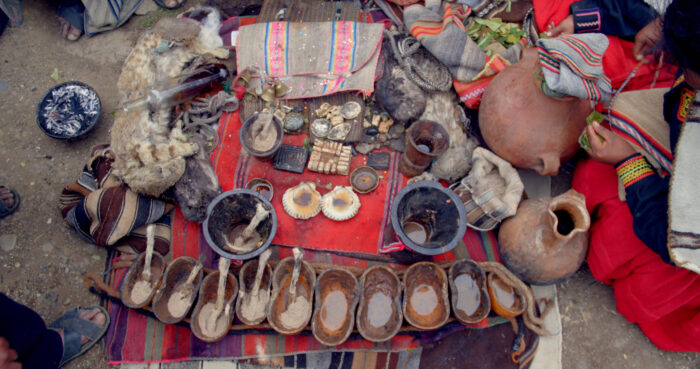
Breaking with tradition
Peruvian journalist Alonso Almenara points out that Wiñaypacha ‘broke with a long tradition in Peruvian cinema: the one of representing Andean people from an implicitly paternalistic and colonial viewpoint.’ Catacora’s ethnographic approach to Pakucha continues to break with tradition and encourages new representations of Indigenous communities. Through Pakucha, Catacora follows in his nephew’s footsteps in contributing to Aymara language cinema and Peru’s ‘cine regional’. Catacora’s next project will be finishing Yanahuara, his nephew’s film which remains incomplete due to his untimely death.
Pakucha is part of the fourth Cine Latino Film Festival and will be screened on May 3 at 6.30pm at Bertha DocHouse, London. Tickets here.

